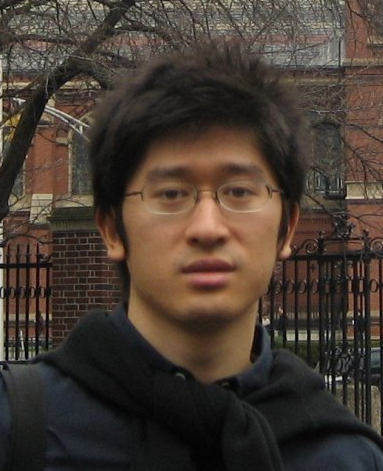The Rubloff Group
- Based in:
Nano-Bio Systems Laboratory (NaBSLab) (description | web site ») - About Gary Rubloff
- Group Members' Areas of Research
- Former Group Members Areas' of Research
- Rubloff Group Presentations
- Biochip Collaborative Publications »
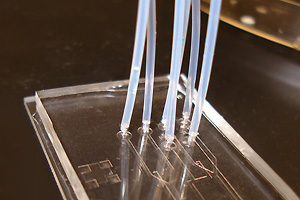
Featured Image: Microfluidic device with pressure actuated valves designed for networked membrane assembly. (Dean Berlin)
The Rubloff Group's Nano-Bio Systems Laboratory (NaBSLab) researches biochemical pathway reconstruction within microfluidic devices. The group's work is novel in that it first develops and fabricates complete bioMEMS devices using soft lithography techniques, then functionalizes patterned electrodes within the device to create spatially and temporally programmable bio immobilization and reaction sites. The Rubloff Group has developed several generations of microfluidic networks and packaging schemes as well as methods for fabricating new functional structures in microfluidics.
Gary W. Rubloff
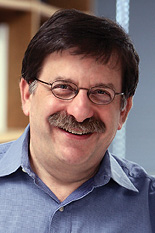
Gary W. Rubloff (Ph.D., University of Chicago, 1971), the Minta Martin Professor of Engineering, holds a joint appointment with the Department of Materials Science and Engineering and the Institute for Systems Research, and serves as the director of the Maryland NanoCenter. He is affiliated with the Fischell Department of Bioengineering, The Department of Electrical and Computer Engineering, and the Institute for Research in Electronics and Applied Physics. He is also a Fellow of the American Physical Society and the American Vacuum Society.
Rubloff's research has included solid state physics, surface physics and chemistry, interfaces, semiconductor materials and processing science and technology, process diagnostics and modeling, manufacturing science, combinatorial materials science, biomaterials and bioMEMS. His semiconductor process research has emphasized the elucidation of chemical and physical mechanisms involved in surface cleaning, thermal oxidation, chemical vapor deposition, and plasma etching, and in pursing these directions he pioneered the exploitation of ultrahigh vacuum process environments and their integration with in-situ surface and interface diagnostics. He received the AVS Gaede-Langmuir Prize in 2000 "for inventive application of surface science and vacuum technology to the semiconductor industry, and for fostering an effective bridge between AVS research and manufacturing.". He holds 19 patents and 6 IBM Invention Achievement Awards.
Contact Information:
- Phone: (301) 405-2949
- E-mail: rubloff@umd.edu
Related External Links:
- Dr. Rubloff's web site »
- Institute for Research in Electronics and Applied Physics
- The Institute for Systems Research »
- The Maryland NanoCenter »
- The Department of Materials Science and Engineering »
Group Members' Areas of Research
Dr. Yi Cheng
Dr. Cheng is currently an Assistant Research Scientist in the Department of Materials Science and Engineering at the University of Maryland. Dr. Cheng received his B.S. in Applied Physics from Anhui University in Hefei, China in 2002. In the same year, he enrolled in the Ph.D. program of the Physics Department at Florida State University to continue his passion in science and research. He worked with Prof. Peng Xiong and Stephan Von Molnar in the field of Condensed Matter Physics at the Center for Materials Research and Technology(MARTECH). He received his Ph.D. in Spring 2009 with a dissertation that emphasized the physics and chemical and biological applications of low-dimensional oxide semiconducting nanostructures. Dr. Cheng was a Robert W. Deutsch Postdoctoral Fellow/Faculty Research Associate at the Institute for Systems Research at University of Maryland from 2009 to 2011. His postdoctoal reseach interest spans from characterization of stimuli-responsive polysaccharides biomaterials for biofabrication, biosynthesis, and bio-assembly to interrogation of bacterial cell-cell signaling in microfluidic bioMEMS devices. His current research is focused on using microfluidic device to study the bacterial social behaviors and the chemotactic properties of the small signaling molecules. He is also affiliated with University of Maryland Energy Frontier Research Center(EFRC) where he conduct researches on visulizing and characterizing electrochemical interfaces in the battery/fuel cell systems using the optical and spectroscopic methods.
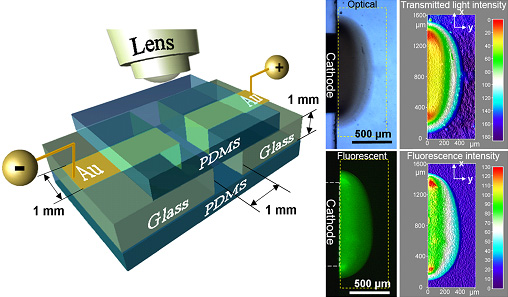
The group has developed a special BioMEMS apparatus for examining the electro-induced gelation process of polysaccharides. Left: Schematic diagram of an all-transparent fluidic channel device with patterned sidewall electrodes in the channel. Right: Electric field-dependent distribution of electrodeposited chitosan hydrogel density. Transmitted light intensity and fluorescence intensity surface mapping of the deposited hydrogel.
Dr. Xiaolong Luo
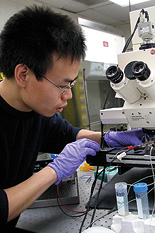
Dr. Luo was using bioMEMS as a platform to reconstruct and interrogate the AI-2 synthesis pathway in the bioMEMS environment. The bioMEMS device enables post-fabricated, signal-guided assembly of labile biomolecules onto localized inorganic surfaces inside microfluidic channels with spatial and temporal programmability. He has demonstrated the programmable assembly and enzymatic activity of the metabolic pathway enzyme Pfs, one of the two AI-2 synthases. The bioMEMS has been optimized for studies of metabolic pathway enzymes to improve the signal-to-background ratio of the site-specific enzymatic reactions. Using the demonstrated techniques, Dr. Luo is working with other Biochip team members to complete the AI-2 synthesis pathway by assembling both AI-2 synthases at separate sites in bioMEMS and by assembling AI-2 synthesis nanofactory at the same localized site in bioMEMS. Inhibition of the AI-2 pathway in bioMEMS is underway to demonstrate the bioMEMS as an anti-microbial drug discovery platform. Free-standing chitosan membranes have also been fabricated and implemented as an efficient and versatile configuration for studies of AI-2 synthesis pathway.

A light microscopic image (left) and a fluorescent microscopic image (right) showing a free-standing chitosan membrane microfabricated at the interface of two converging microchannels by pH gradient.

Setup of membrane fabrication in microfluidics. Acidic chitosan solution and basic buffer solution are pumped into microfluidic channel to form chitoan membrane at the interface of two converging microchannel. Air plugs are included in the vertically placed syringes to generate steady flows.

Left: A cross-channel bioMEMS device with electric connections and fluidic input/output. Right: A bioMEMS device with mulitple electrodes within each channel.
Dr. Luo received his Bachelor of Science & Engineering degree in Mechatronics from Zhejiang University in Hangzhou, China in July 2001. He received his Master of Science & Engineering degree in Mechanical Engineering from Temple University in Philadelphia in August 2003. His thesis focused on PIV measurement and CFD simulation of flow field inside a human uterus model for cryoablation, which motivated his enthusiasm in the field of Bioengineering and attracted him into the Graduate Program in Bioengineering at the University of Maryland in August 2003. He received his Ph.D. in December 2008. His Ph.D. disertation focused on studying biomolecular functionalization and enzymatic reactions in a bio-microelectromechanical system (bioMEMS). Dr. Luo is currently a research associate at the University of Maryland Biotechnology Institute.
Former Group Members' Areas of Research
Susan Buckhout-White
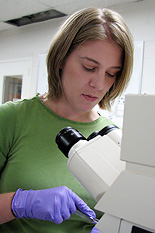
Susan was investigating the materials science aspects of the chitosan biopolymer interconnect. The Rubloff Group's early work has shown that chitosan may grow in a nucleation and growth type behavior. Susan has demonstrated that the electrodeposited chitosan confines within one mm of the edge of the patterned electrode and is currently investigating how and where molecules bind to the chitosan surface and once bound if there is any significant diffusion. Her work also aims to use chitosan as a platform to enable detection of the reaction products. Several chitosan based sensors have been studied with the most promising being a novel method for creating spatially localized sites for surface enhanced Raman spectroscopy (SERS). This site incorporates silver nanoparticles into the chitosan matrix to allow for chemical identification during the recreation of the metabolic pathway.
Susan earned her B.S. from the University of Marland in materials science and engineering in 2004. She bagan work with the Rubloff Group during her senior year and continued on to the Ph.D. program.
Dean Larios Berlin
Dean is currently conducting research on enzyme immobilization n microfluidic devices using chitosan. Recent developments in the Rubloff Group have shown that chitosan can be used as biomechanical interconnects facilitating the electrodeposition of active enzyme inside the device. Dean hopes to build on this research for novel immobilization techniques.
Dean earned his B.S. from the Massachusetts Institute of Technology in materials science and engineering in 2000. He then continued his studies there, earning a M.S. in semiconductor processing in 2002. His thesis research was in silicon germanium waveguide structures fabricated by chemical vapor deposition. This thesis research led to a U.S. Patent. From 2002 until 2007, Dean worked at Applied Materials in Santa Clara, CA as a process engineer in the low temperature CVD division. By the time he left the group in March 2007, he had installed production tools world-wide for DRAM customers and led startup teams that installed the first 300MM SiGe epitaxial systems in Taiwan. In 2009, Dean earned his M.S. from the University of Maryland's Fischell Department of Bioengineering. His thesis research focused on enzyme immobilization in microfludidcs.
Rubloff Group Presentations
- Yi Cheng, X. L. Luo, Jordan Betz, Omar Bekdash, G. W. Rubloff,Mechanism and direct visualization of Electrodeposition of Polysaccharide Chitosan (Talk), Southern Biomedical Engineering Conference(SBEC), College Park, MD, April (2010).
- Yi Cheng, X. L. Luo, J. Betz, G. W. Payne, W. E. Bentley and G. W. Rubloff, Electroaddressable biofabrication of polysaccharide scaffolds for programmable cell assembly (Talk), 2010 International Conference on Biofabrication, Philadelphia, PA, October (2010).
- Omar Bekdash, Jordan Betz, Yi Cheng and Gary W. Rubloff, Applicability of Surface Enhanced Raman Spectroscopy for Determining the Concentration of Adenine and S-Adenosyl Homocysteine in a Microfluidic System, Southern Biomedical Engineering Conference(SBEC), College Park, MD, April (2010).
- Jordan Betz, Yi Cheng, Omar Bekdash, Susan Buckhout-White and Gary W. Rubloff, Formation of Dendritic Silver Substrates by Galvanic Displacement forSurface Enhanced Raman Spectroscopy, Southern Biomedical Engineering Conference(SBEC), College Park, MD, April (2010).
- X. L. Luo, Hsuan-chen Wu, Chen-yu Tsao, Yi Cheng, G. W. Rubloff and W. E. Bentley, Biofabrication of 3D biopolymer scaffolds for cell assembly in microfluidics, 2010 International Conference on Biofabrication, Philadelphia, PA, October (2010).
- X. L. Luo, Hsuan-Chen Wu, Chen-Yu Tsao, Yi Cheng, Gary W. Rubloff and William E. Bentley, Micro-sandwich in Microfluidics: 3D Biopolymer Membranes for Cell Assembly, 2010 MicroTAS Conference, Groningen, The Netherlands, October (2010).
- Yi Cheng, X. L. Luo, Hsuan-Chen Wu, Chen-Yu Tsao, Jordan Betz, Gregory F. Payne, William E. Bentley and Gary W. Rubloff, Spatially Programmable Cell Assembly and Quantitative Visualization in bioMEMS (Talk), AA7.2, Materials Research Society Spring Meeting, San Francisco, CA, April (2011).
- Yi Cheng, X.L. Luo, J. Betz, C.Y. Tsao, H.C. Wu, G.F. Payne, W.E. Bentley and G. W. Rubloff, Electrically Controlled Biofabrication with Stimuli-Responsive Polysaccharideand Their Visualization in Microfluidic Devices (Talk), Session: BN+NM-TuM2 (Biofabrication and Novel Devices Focus Topic), AVS 58th Annual International Symposium and Exhibition, Nashville, TX, October (2011).
- Yi Cheng, Jessica Terrell, X. L. Luo, J. Betz, H.C. Wu, G.F. Payne, W.E. Bentley and G. W. Rubloff, Immobilization and Culturing of Mammalian Cells with Biocompatible Electrodeposition of Calcium Alginate Gel in Microfluidic Devices (Poster),Topic No. 1.3 Cell Culture / Handling / Analysis, The 15th International Conference on Miniaturized Systems for Chemistry and Life Sciences (MicroTAS), Seattle, WA, October (2011).
- Jordan Betz, Yi Cheng, Omar Bekdash, Gary W. Rubloff, SERS on a dime: Galvanic displacement as a rapid, robust, and simple method for SERS substrate fabrication, American Chemical Society 241st National Meeting, Anaheim, CA, March (2011).
- Jordan Betz, Yi Cheng, Omar Bekdash, Gary W. Rubloff, A Novel Galvanic Displacement Reaction as a Rapid, Robust, and Simple Method for SERS Substrate Fabrication Compatible with Microfluidic Device Fabrication Techniques, AA2.1, Materials Research Society Spring Meeting, San Francisco, CA, April (2011).
- X. L. Luo, Hsuan-Chen Wu, Chen-Yu Tsao, Yi Cheng, Gary W. Rubloff and William E. Bentley, Cell Signaling in Membrane-based 3D Microenvironments towards Deciphering Quorum Sensing, AA7.4, Materials Research Society Spring Meeting, San Francisco, CA, April (2011).
- X. L. Luo, H.C. Wu, C.Y. Tsao, Yi Cheng, J. Betz, G. W. Rubloff, and W.E. Bentley, Bacterial Communication in Controlled 3D Microenvironments, Session: BN+NM-TuM6 (Biofabrication and Novel Devices Focus Topic), AVS 58th Annual International Symposium and Exhibition, Nashville, TX, October (2011).
- Jordan Betz, Yi Cheng, C.Y. Tsao, G. W. Rubloff, and W.E. Bentley, Simultaneous Bacterial Transformation and Localizationwithin a Microfluidic Device, Session: BN+NM-TuM11 (Biofabrication and Novel Devices Focus Topic), AVS 58th Annual International Symposium and Exhibition, Nashville, TX, October (2011).
- Tanya Gordonov, Jessica Terrell, Hsuan-Chen Wu, Chen-Yu Tsao, Darryl Sampey, XiaoLong Luo, Yi Cheng, Yi Liu, Gary Rubloff, Gregory Payne, William Bentley, Enzymatic assembly and protein engineering for advancing molecular detection techniques, Abstract of the American Chemical Society, Volume: 241 Meeting Abstract: 503-BIOT Published: March 27 2011.
- Jessica Terrell, Tanya Gordonov, Hsuan-Chen Wu, Chen-Yu Tsao, Darryl Sampey, XiaoLong Lou, Yi Cheng, Yi Liu, Gary Rubloff, Gregory Payne, William Bentley, Film electrodeposition for on-chip cell culture and analysis at defined addresses, Abstract of the American Chemical Society, Volume: 241 Meeting Abstract: 80-BIOT Published: March 27 2011.
- Benjamin D. Liba, Kelsey M. Gray, Yi Cheng, Gary W. Rubloff, William E. Bentley, Gregory F. Payne, Integrating Biology and Electronics: Electroaddressing Biopolymer Hydrogels within a Microfabricated Fluidic Channel, 2012 Mid Atlantic Micro/Nano Alliance Spring Symposium, Annapolis, Maryland, March 27, 2012.
- Jordan F. Betz, Yi Cheng, Chen-Yu Tsao, Hsuan-Chen Wu, Gregory F. Payne, William E. Bentley and Gary W. Rubloff, Calcium-Alginate Mediated Nucleic Acid Delivery in a Microfluidic Device, 2012 AIChE Annual Meeting, Pittsburgh, PA, October 28 - November 2, 2012.
- X. L. Luo, H.C. Wu, C.Y. Tsao, Yi Cheng, G. W. Rubloff, and W.E. Bentley, In-situ biofabrication of stratified biofilm mimics for direct observation of bacterial signaling, Bioengineering Conference (NEBEC), 2012 38th Annual Northeast, Philadelphia, PA, 16-18 March 2012.
